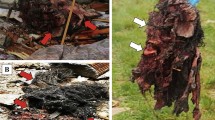Abstract
In this study, head injury by impact force was evaluated by numerical analysis with 3-dimensional finite element (FE) model. Brain deformation by frontal head impact was analyzed to evaluate traumatic brain injury (TBI). The variations of head acceleration and intra-cranial pressure (ICP) during the impact were analyzed. Relative displacement between the skull and the brain due to head impact was investigated from this simulation. In addition, pathological severity was evaluated according to head injury criterion (HIC) from simulation with FE model. The analytic result of brain damage was accorded with that of the cadaver test performed by Nahum et al. (1977) and many medical reports. The main emphasis of this study is that our FE model was valid to simulate the traumatic brain injury by head impact and the variation of the HIC value was evaluated according to various impact conditions using the FE model.
Similar content being viewed by others
Abbreviations
- [M]:
-
Mass matrix
- [C]:
-
Damping matrix
- [K]:
-
Stiffness matrix
- G :
-
Shear stress relaxation modulus
- G o :
-
Short term shear modulus
- G ∞ :
-
Long term shear modulus
- β:
-
Decay factor
References
Al-Bsharat, A. S., Hardy, W. N., Yang K. H., Khalil, T. B., Tshman, S. and King A. I., 1999, “Brain/Skull Relative Displacement Magnitude due to Blunt Head Impact : New Experimental Data and Model,” In Proceedings of the 43th Stapp Car Crash Conference, SAE 99SC22.
Gennarelli, T. A., Ommaya, A. K. and Thibault, L. E., 1971, “Comparison of Translational and Rotational Head Motions in Experimental Cerebral Concussion,” Proceedings 15th Stapp Car Crash Conference, New York, Society of Automotive Engineers, pp. 797–803.
Holbourn, A., 1943, “Mechanics of Head Injuries,” The Lancet, Vol. 2, pp. 438–441.
Kleiven, S. and Holst, H., 2002, “Consequences of Head Size Following Trauma to the Human Head. Journal of Biomechanics.” Vol. 35, pp. 153–160
Lee, M. C. and Haut, R. C., 1989, “Insensitivity of Tensile Failure Propecties of Human Bridging Veins to Strain Rate: Implications in Biomechanics of Subdural Homatoma,” Journal of Biomechanics, Vol. 22, pp. 537–542.
Luchter, S. and Walz, M. C., 1996, “Long Term Consequences of Head Injury,” In: Bandak, F. A., Eppinger, R. H., and Ommaya, A. K., Traumatic Brain Injury - Bioscience and Biomechanics. Mary Ann Liebert Inc., New York, pp. 9–18.
Margulies, S. S., Thibault, L. E., and Gennarelli, T. A., 1990, “Physical Model Simulations of Brain Injury of Primate,” Journal of Biomechanical Engineering, Vol. 23(8), pp. 823–836.
Miller, R. T, and Margulies, S. S., 1998, “Finite Element Modeling Approaches for Predicting Injury in an Experimental Model of Severe Diffuse Axona1 Injury,” SAE No. 983154.
Nahum, S., Smith, R. and Ward, C., 1977, “Intracranial Pressure Dynamics During Head Impact,” In Proceedings of 21st Stapp Cur Crash Conference, pp. 339-366.
Shuck, L. and Advani, S., 1972, “Rheological Response of Human Brain Tissue in Shearing,” Journal of Basic Engineering, Transaction of the ASME, pp. 905-911.
Suh, C. M., Kim, S. H. and Kim, D. K., 2001, “Finite Element Analysis and Experimental Study about Damage Behavior of Glass by Oblique Impact of Steel Ball,” Journal of KSME, Vol. 25(5), pp. 800–905.
Willinger, R., Kang, H. S. and Diaw, B., 1999, “Three-Dimensional Human Head Finite-Element Model Validation against Two Experimental Impacts,” Annals of Biomedical Engineering, Vol. 27, pp. 403–410.
Author information
Authors and Affiliations
Corresponding author
Rights and permissions
About this article
Cite this article
Suh, CM., Kim, SH. & Oh, SY. Analysis of traumatic brain injury using. J Mech Sci Technol 19, 1424–1431 (2005). https://doi.org/10.1007/BF03023901
Received:
Revised:
Issue Date:
DOI: https://doi.org/10.1007/BF03023901




